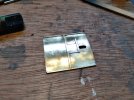Dave
Western Thunderer
The last of the sheet brass work has been completed.

The hole in the roof is for the safety valves, which were on top of the firebox on the majority of Mannings.
I still need to make another injector and the chassis still needs pickups but after those little jobs it's all down to paint and final assembly.
I have ordered some rivet transfers and will practice before applying them to the loco. I also want to see if they will remain in place if masking tape is used over them as I want to mask various panels of cab and tank for the two-tone colours. I briefly considered enquiring with one of the professional painters about lining it as in the ex-works livery, shown in my first post, but I think they'll be way above my league.

The hole in the roof is for the safety valves, which were on top of the firebox on the majority of Mannings.
I still need to make another injector and the chassis still needs pickups but after those little jobs it's all down to paint and final assembly.
I have ordered some rivet transfers and will practice before applying them to the loco. I also want to see if they will remain in place if masking tape is used over them as I want to mask various panels of cab and tank for the two-tone colours. I briefly considered enquiring with one of the professional painters about lining it as in the ex-works livery, shown in my first post, but I think they'll be way above my league.




















